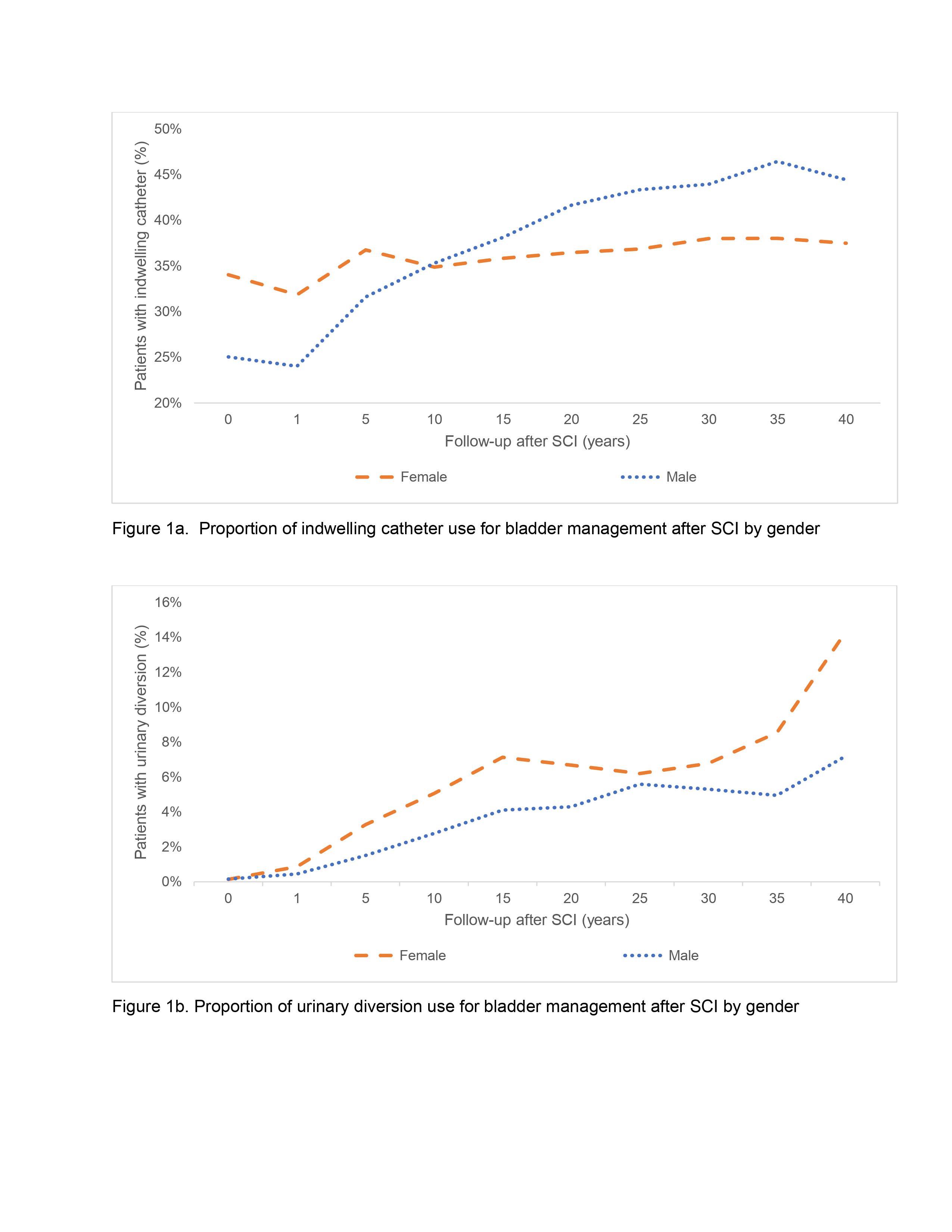Back
Poster, Podium & Video Sessions
Podium
PD24: Urodynamics/Lower Urinary Tract Dysfunction/Female Pelvic Medicine: Neurogenic Voiding Dysfunction
PD24-05: Bladder Management and Quality of Life by Gender after Spinal Cord Injury: Results from 40 Years of Follow-up
Saturday, May 14, 2022
10:10 AM – 10:20 AM
Location: Room 245
Paige Nichols*, Rochester, MN, Brian Goh, Boston, MA, Elizabeth Bearrick, Rochester, MN, Stuart Hershman, Boston, MA, Katherine Anderson, Rochester, MN
- PN
Podium Presenter(s)
Introduction: Clean intermittent catheterization (CIC) is the gold standard bladder management strategy for neurogenic bladder dysfunction after spinal cord injury (SCI). Population-based studies show a high rate of conversion from CIC to indwelling catheters over time. Long-term data comparing bladder management strategies between genders and associated difference in quality of life (QoL) is under-studied. We aim to describe bladder management trends and associated QoL by gender in a large SCI cohort.
Methods: Using the National Spinal Cord Injury Database (1972-2016), bladder management method was determined at time of discharge, 1-year post discharge and in 5-year increments after discharge. QoL data was obtained using the Satisfaction With Life Scale (SWLS). Bladder management was categorized as: normal voiding, CIC, indwelling catheter (urethral or suprapubic), and urinary diversion (UD). Rates of bladder management utilization by gender were compared with chi-squared testing. Non-parametric analysis was performed using the Wilcoxon test to describe associations between SWLS and bladder management.
Results: Our initial cohort at time of discharge included 21,291 males and 5,754 females, at which time CIC was most frequently utilized. Males were more likely than females to discharge on CIC (54.0% vs 43.1%; p<0.01). One-year post SCI, rates of CIC decreased for both males and females (-8.5% and -6.8%, respectively). Rate of indwelling catheter use and rate of UD use for bladder management by gender are described in Figure 1. At year one, SCI patients who performed CIC reported higher mean total SWLS compared to those with an indwelling catheter in both male (18.6 vs 17.0, p <0.01) and female (18.7 vs 17.5, p = 0.01) patients, respectively. All SCI patients with UD report similar SWLS compared to CIC.
Conclusions: The prevalence of CIC amongst SCI patients decreases in the first year with long-term indwelling catheter use being more prevalent in males. Females are more likely to undergo UD for bladder management. This may reflect the unique challenges women with SCI face in performing CIC. The comparable life satisfaction associated with UD versus CIC in females paired with the decreased rate of CIC in women argues for further research into the benefits of diversion (continent or incontinent) in this population.
Source of Funding: None

Methods: Using the National Spinal Cord Injury Database (1972-2016), bladder management method was determined at time of discharge, 1-year post discharge and in 5-year increments after discharge. QoL data was obtained using the Satisfaction With Life Scale (SWLS). Bladder management was categorized as: normal voiding, CIC, indwelling catheter (urethral or suprapubic), and urinary diversion (UD). Rates of bladder management utilization by gender were compared with chi-squared testing. Non-parametric analysis was performed using the Wilcoxon test to describe associations between SWLS and bladder management.
Results: Our initial cohort at time of discharge included 21,291 males and 5,754 females, at which time CIC was most frequently utilized. Males were more likely than females to discharge on CIC (54.0% vs 43.1%; p<0.01). One-year post SCI, rates of CIC decreased for both males and females (-8.5% and -6.8%, respectively). Rate of indwelling catheter use and rate of UD use for bladder management by gender are described in Figure 1. At year one, SCI patients who performed CIC reported higher mean total SWLS compared to those with an indwelling catheter in both male (18.6 vs 17.0, p <0.01) and female (18.7 vs 17.5, p = 0.01) patients, respectively. All SCI patients with UD report similar SWLS compared to CIC.
Conclusions: The prevalence of CIC amongst SCI patients decreases in the first year with long-term indwelling catheter use being more prevalent in males. Females are more likely to undergo UD for bladder management. This may reflect the unique challenges women with SCI face in performing CIC. The comparable life satisfaction associated with UD versus CIC in females paired with the decreased rate of CIC in women argues for further research into the benefits of diversion (continent or incontinent) in this population.
Source of Funding: None


.jpg)
.jpg)